To see a butterfly emerging from the pupa to uncurl and spread its wings is akin to watching a miracle. Following on from last week’s post, here is my record of what might be a once-in-a-lifetime experience: witnessing individual butterflies emerge from the pupa (chrysalis).
Within the pupa, the caterpillar gradually metamorphosises into its adult form: a butterfly. Prior to a butterfly emerging, the pupa casing becomes transparent and the dark shape within is just visible, but it is only at the point when the casing starts to split that I could be sure that the actual moment of emergence was happening. Even with many butterflies emerging within a few days, I was only able to capture on camera the actual moment a few special times.
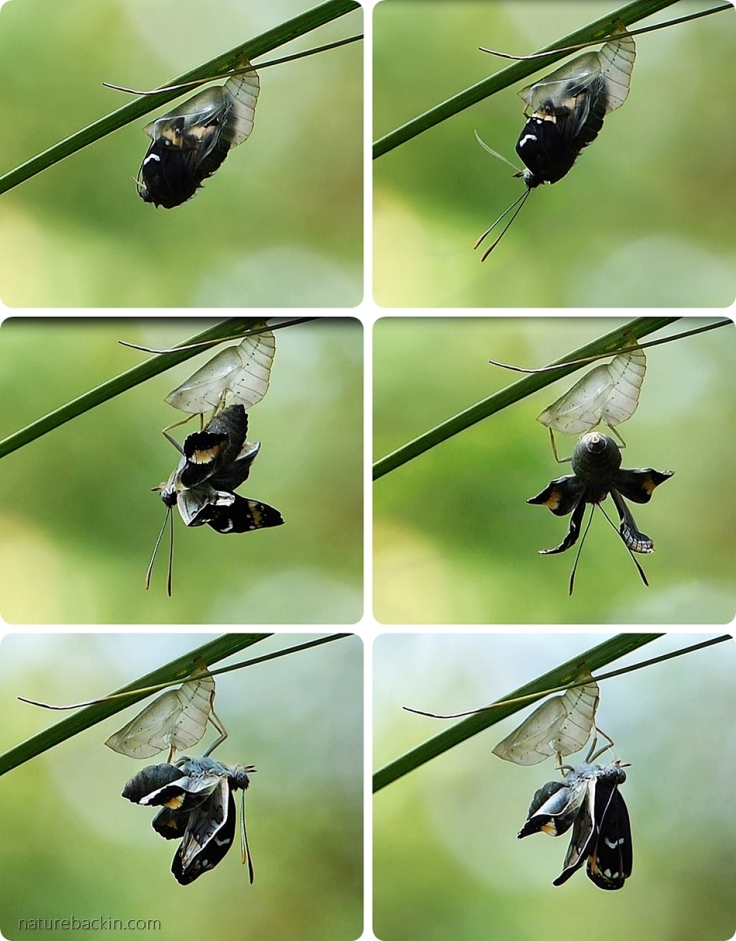
Above is a sequence of stills clipped from a video I took of a female Battling Glider (Cymathoe alcimeda) butterfly emerging
While in its pupa, each butterfly is encased upside down with its head at the pointed end and its abdomen at the end attached to the leaf from which the pupa is suspended. The wings are folded, something like a parachute I imagine, and the antennae and the proboscis (in two parts) are curved forward to lie on the underside of the butterfly as it develops.
As the butterfly emerges the antennae and proboscis unfurl almost with a flourish. As the upside-down butterfly slides out of the casing the wings drop down curled and crumpled. As I watched, each newly emerged butterfly hung upside down holding onto the pupa casing and moved from side to side as it worked to expand its wings, pumping body fluids into the veins of the wings, and at the same time working on coiling and uncoiling the proboscis (tongue) as the process of fusing the two parts of the proboscis into one began.
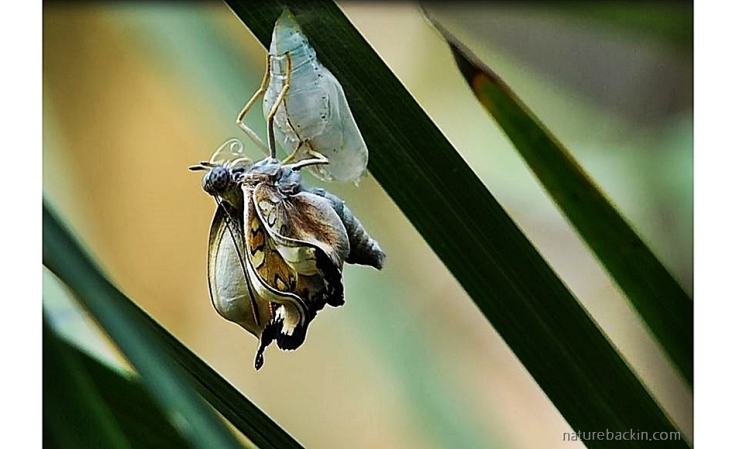
In the photo above a male Battling Glider butterfly has recently emerged from the pupa. It is working at expanding its wings that are still crumpled and curled
In the headline photo of this post, I have pictorialized the photo to accentuate the fact that a newly emerged butterfly, before its wings have fully unfolded, can resemble more an ornately bizarre orchid than a recognizable butterfly.
While watching the butterflies that had already emerged, I kept an eye on several pupae that looked ready for emergence to commence, choosing those that were not obscured by leaves, were not in too much shadow, and that I could see without moving around too much. Doing this meant that I missed seeing several butterflies emerging, but I could not be everywhere at once!

This female Battling Glider, her empty pupa casing to her right, is nearly ready to fly. I filmed her emergence from the pupa as can be seen in the video below. In the background, a male butterfly can be seen as he also prepares for his first flight
I waited for three hours to be able to video the emergence of a butterfly from the very beginning. As bad luck would have it, the wind started gusting just as the butterfly was unfurling, and the leaf it was on danced up and down in the breeze and out of the frame. I made the best of it and I do hope you enjoy this short video. Each clip is in real time.
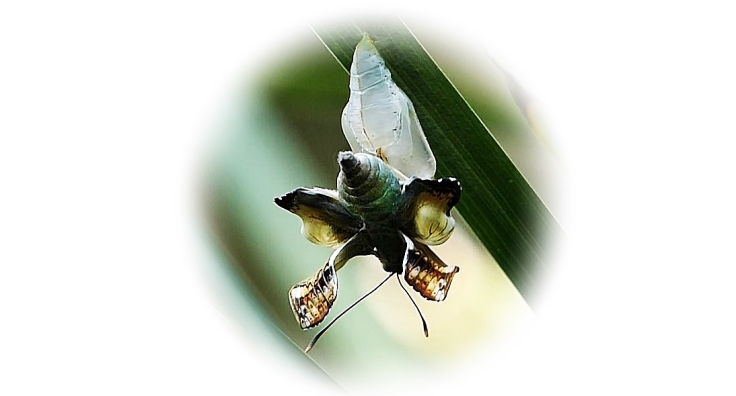
And here is Part II of the video comprising clips of four other butterflies that I filmed while they were emerging, if you have the time and inclination to see more. This video is approximately 4 minutes in duration. Audible in the soundtrack include the sounds of neighbourhood dogs, Laughing Doves, Double-collared Sunbirds, Dark-capped Bulbuls, a distant train, Purple-crested Turaco, a passing car, and a Hadeda Ibis.
Last week’s post featured photographs of Battling Glider butterflies expanding their wings, coiling and uncoiling the proboscis in order to fuse the two parts into one, and preparing for flight. But I also watched the many butterflies that remained in the vicinity after their maiden flight. Many of them flitted about and then perched, spreading their wings so to catch the warmth of the afternoon sunshine. Butterflies, like most flying insects, need to warm the flight muscles before they are able to fly. Basking in the sun can aid this process.
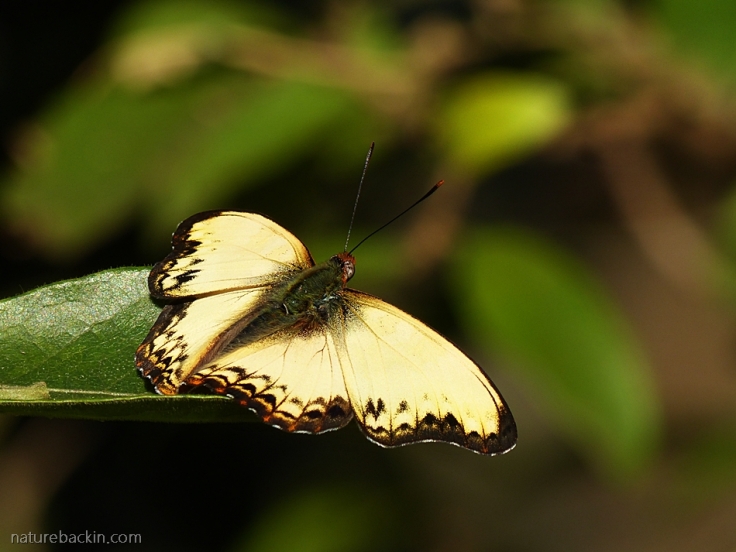
Above is a male Battling Glider butterfly basking in the sun after it had already taken its first flight
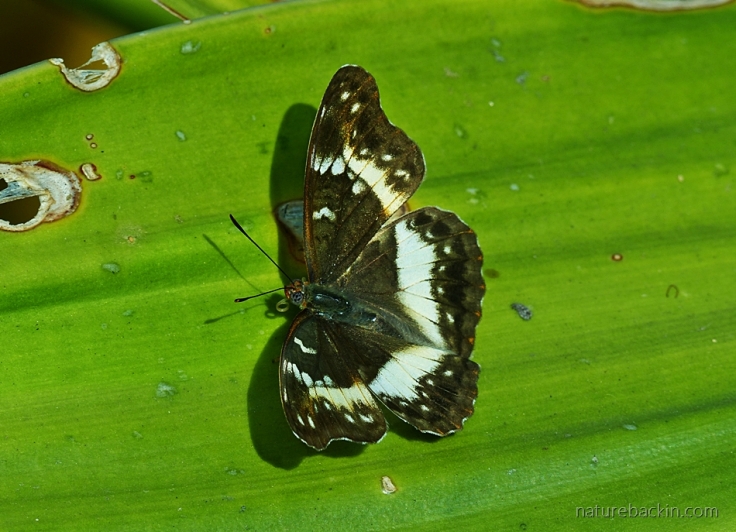
The following morning, and further afield I saw this female Battling Glider butterfly catching the warmth of the sunshine
In the days following their emergence, the male Battling Glider butterflies were much more in evidence than the females. The males flew high, engaged in chasing other male butterflies, and rested in the sunshine in trees and shrubs near to where they had hatched. Fewer females were as obvious, and some that I did see were perching on the ground or deeper into the vegetation. Typically, prior to mating, female butterflies are more sedentary than the males. I only once saw a Battling Glider butterfly taking nectar from a flower – a flower of the Canary Creeper (Senecio tamoides).
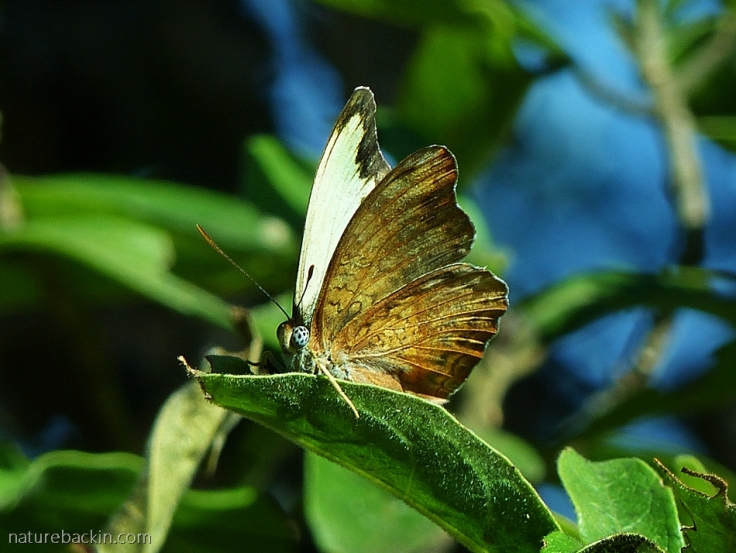
A male Battling Glider butterfly at rest
Different species of butterfly have their own courtship rituals, and I have not discovered how the Battling Gliders come to choose their mates. However, I did come across one mating pair settled on the ground in the lawn as they mated, with the female occasionally slowly flapping her wings up and down.

Above and below, a mating pair of Battling Glider butterflies
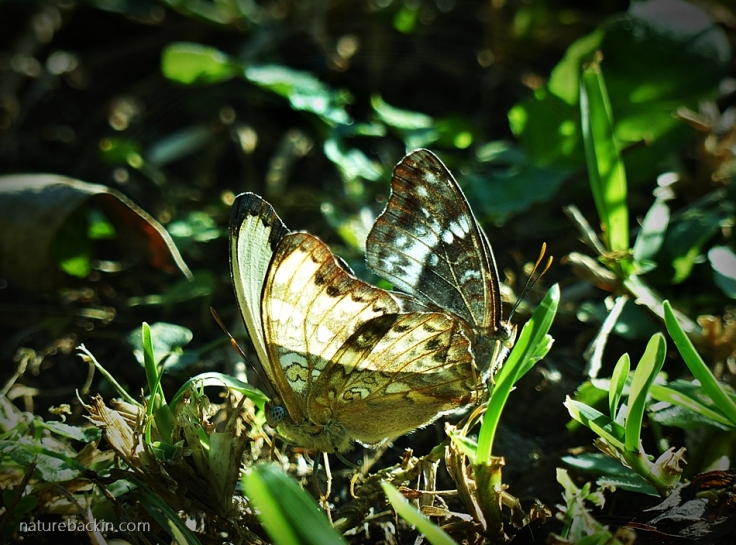
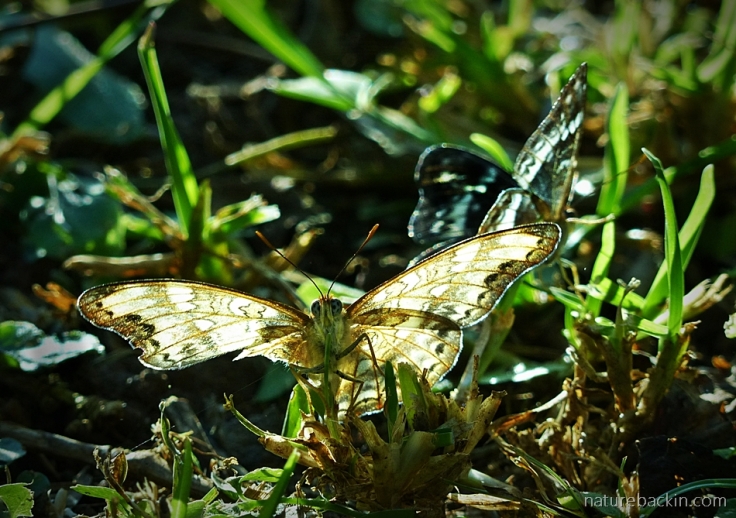
Above is the same pair of butterflies after they have finished mating. One of the wings of the male butterfly is damaged with a piece missing. It does not take long for butterfly wings to become rather battered compared to when the butterfly was newly emerged from the pupa
In most species of butterfly the males die not long after mating, their life cycle having been completed. The female, however, still has to lay her eggs. When mating, the male deposits the sperm into a special storage sac within the female, and it is only when in the process of her laying actually the eggs that each egg gets individually fertilised as the eggs pass by the storage sac as the female oviposits.
This mechanism enables the female to lay the eggs once she has chosen a suitable site, but I don’t know how long she can delay after the eggs start forming in her body. A suitable site for egg laying requires the presence of the larval host plant (or plants) specifically required by each species of butterfly. In many species of butterfly, the larvae (caterpillars) can eat the leaves of only one or a few species of plants. In the case of the Battling Gliders, the caterpillars eat the leaves of only one plant species: Kiggelaria africana, the Wild Peach.
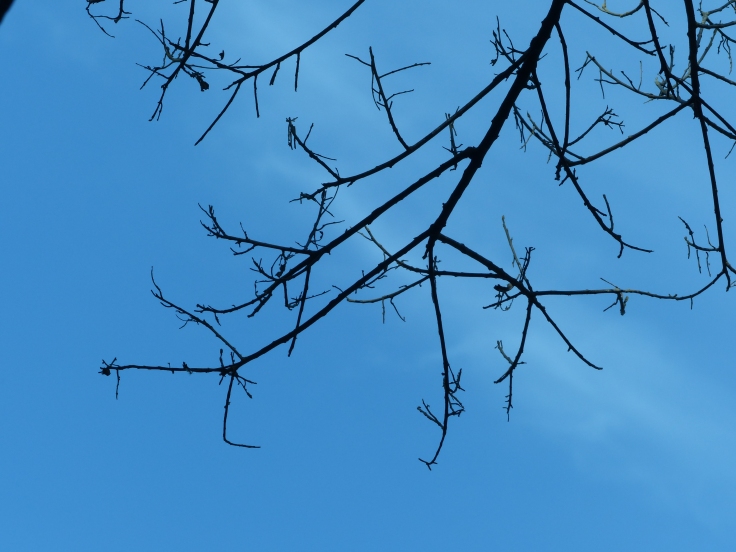
The Kiggelaria africana (Wild Peach) tree in our garden that was denuded of its leaves by the Battling Glider caterpillars before they moved out of the tree to pupate in nearby vegetation
We have two Kiggelaria africana trees, which grow at opposite ends of the garden, but it appears that the Battling Gliders utilised only one of these two trees. The caterpillars ate all the leaves on this tree, and then moved into the neighbouring Curtisia dentate (Assegai) trees to pupate. Many of them attached their pupa to the underside of the Assegai tree leaves, and others moved down to pupate in the Dietes grandiflora (Wild Iris) plants growing underneath these trees and under the Wild Peach tree, as I mentioned in last week’s post.
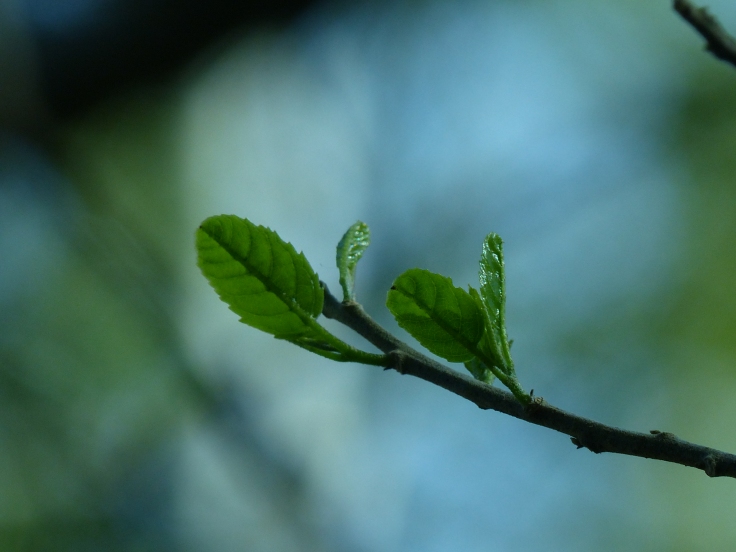
Amazingly, the Wild Peach tree started sprouting new leaves even though it is now early winter, with shoots being noticeable while the Battling Gliders were still pupating. The tree is rapidly putting forth new leaves, demonstrating that the caterpillars did no long-term damage to the health of the tree, and that the tree is able to regenerate to host the next generation of caterpillars
When searching for a larval host plant butterflies can use their feet to scrape the surface of leaves so as to be able to detect if the leaves emit the odour characteristic of their larval host plants. Butterflies lay their eggs on or near the food plants, usually, as is the case with the Battling Glider, laying their eggs on the underside of leaves, with a sticky substance effectively gluing the eggs to the leaf.
Since watching the butterflies emerging, I have been on the lookout to see if I can spot Battling Glider females laying their eggs and I have also looked to see if I can find any eggs that have been laid. I have seen neither, and I am wondering if the females are waiting for more leaves to appear on the Wild Peach tree, their larval host plant, before they lay their eggs. So this is still work in progress.
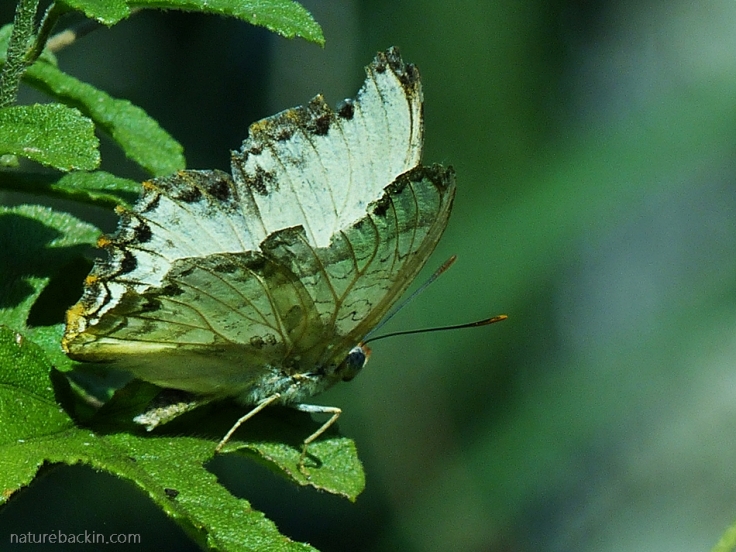
A male Battling Glider with slightly tatty wings a few days after emerging
I am still seeing a few Battling Gliders flying in the garden, though the peak of butterflies emerging from their pupal state is over. I will continue to keep an eye on the Wild Peach trees in the hopes of seeing the next generation of butterflies in their larval form.
I am learning that conserving or planting larval host plants is crucial in supporting butterflies. A well known example is the dependence of Monarch butterflies on the milkwood species that are their larval host plants. The biggest threat to butterflies is habitat loss, and after that the use of pesticides. Other hazards include the killing of caterpillars not only in farming contexts but also in suburban gardens and parks, and butterfly collectors too take a toll, especially on “trophy” species.
For those of us lucky enough to have gardens or even balconies, steps to attracting and sustaining butterflies include taking an interest in providing native plants, avoiding the use of insecticides, and understanding that caterpillars are butterflies in another incarnation. As George Carlin is reputed to have said: “The caterpillar does all the work, but the butterfly gets all the publicity”.
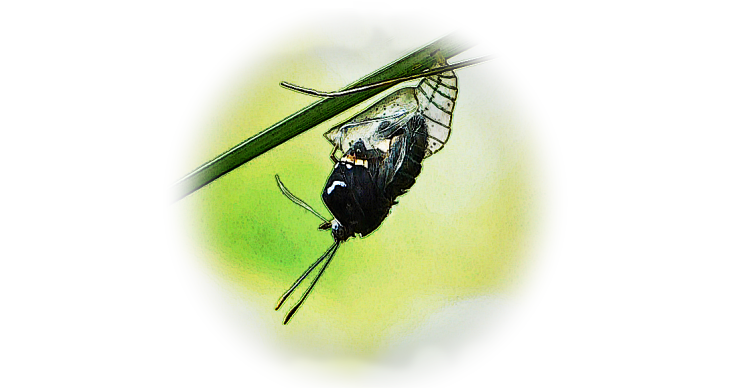
Sources: Department of Horticulture. 2019. All about butterflies. University of Kentucky, College of Agriculture, Food and Environment. http://www.uky.edu/hort/butterflies/all-about-butterflies#mating; Eeles, P. 2015. Butterfly Anatomy. Dispar: The Online Journal of Lepidoptera. http://www.dispar.org/reference.php?id=6; Gardening for Wildlife.com. 2006-1-2019. Butterflies mating. http://www.gardening-for-wildlife.com/butterflies-mating.html; Woodhall, Steve. 2013. Butterflies of South Africa. Pocket Guide. Cape Town: Struik Nature; VanSomeren, Lindsay. 2016. How do caterpillars turn into butterflies and moths through Metamorphosis? UntamedScience. https://www.untamedscience.com/biology/ecology/ecology-articles/butterflies-metamorphosis/
Watch a video of a caterpillar pupating (in real time): Eeles, Pete. 2013. Wood White larva pupating. https://www.youtube.com/watch?v=qyqFc8CYXyQ
Posted by Carol

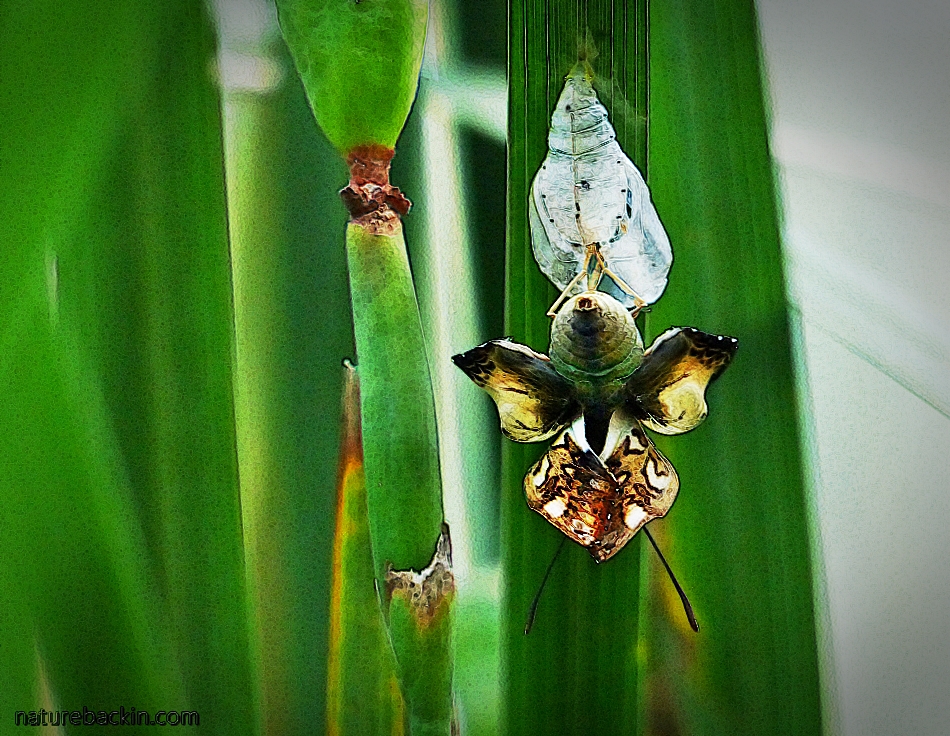







June 12, 2019 at 6:13 am
Wonderful photos and video, and a most informative post. It makes me keen to try and find similar activity around here. There’s so much to be said for paying attention to the little things that are so easily missed.
LikeLiked by 1 person
June 13, 2019 at 7:02 pm
Thank you Graham. Yes being more observant can yield lots, but perhaps serendipity trumps even that 🙂
LikeLiked by 1 person
June 8, 2019 at 2:07 am
That Hadeda Ibis must be a rather loud neighbor! The videos and the still shots are utterly exquisite, Carol. I agree you have very much outdone yourself here. It must have been a breathtaking experience.
LikeLike
June 8, 2019 at 2:12 am
Oh… and we planted several forms of native milkweed here in order to attract the Monarchs.
LikeLiked by 1 person
June 9, 2019 at 7:47 pm
Great to support the monarchs and the other creatures that depend on milkweed.
LikeLiked by 1 person
June 9, 2019 at 7:46 pm
Thank you Gunta. Yes it was an amazing experience. So much going on in such tiny creatures and so much beauty too.
Some people don’t like the calls of hadedas but I have grown up with them and love having them around. They can be loud but they don’t call all the time and they are full of character.
LikeLiked by 1 person
June 9, 2019 at 10:57 pm
I think I would love the call of the hadedas as long as they didn’t wake me up! 😀 But then it might be OK if I grew up with the sound. What a treat that you gave us a hint of what they sound like.
LikeLiked by 1 person
June 7, 2019 at 2:37 pm
A beautifully done nature study.
LikeLiked by 1 person
June 9, 2019 at 7:40 pm
Thanks very much Sherry.
LikeLike
June 7, 2019 at 2:37 pm
Simply stunning. There is a meditative quality to this post that has left me feeling peaceful and humble. I am in awe of your patience, Carol, but also in awe of what you have shown us. The soundtrack on the second series adds extra magic. Thank you!
LikeLiked by 1 person
June 9, 2019 at 7:40 pm
Thanks Sandra. It was incredible and quite mesmerising so it didn’t feel like being patient 😊 It was nice that the birds were so active and audible.
LikeLiked by 1 person
June 7, 2019 at 10:01 am
Wow this is an awesome post and what butterflies they are the best. Too good, thanks for the awesome share.
LikeLiked by 1 person
June 9, 2019 at 7:36 pm
Thanks very much Kamal. It was good to share seeing the butterflies emerging.
LikeLiked by 1 person
June 10, 2019 at 5:28 am
Yes so true and welcome so much.
LikeLiked by 1 person
June 7, 2019 at 4:59 am
You never fail to please and this week you have outshone yourself. This is an absolutely marvellous documentary Carol. Well done to you!
LikeLiked by 1 person
June 7, 2019 at 7:31 am
Thank you very much Anne. It was a fantastic opportunity to try to document the process and it was totally absorbing.
LikeLike
June 7, 2019 at 3:26 am
Carol you have brought magic into my morning, thank you!
LikeLiked by 1 person
June 7, 2019 at 7:28 am
Thank you Christeen – it has been a pleasure to try to share the magic. The time spent watching the butterflies will become a treasured memory.
LikeLike
June 7, 2019 at 2:20 am
Yet another inspiring post, Carol! A heartfelt thank you for putting this together! I love how the videos show the fat little tales growing slimmer as the wings unfurl – it’s not something I have even noticed or thought of before!
LikeLiked by 1 person
June 7, 2019 at 7:26 am
Thank you very much Dries. It was a pleasure to put it all together so as to be able to share a special experience. Yes, I also speculated that the engorged abdomens slim down as they expel fluid into the veins of the wings to expand them.
LikeLike
June 6, 2019 at 11:19 pm
Amazing to watch this fascinating process, Carol. You are so patient to film them emerging. I don’t know as I’d be able to do that!
LikeLiked by 1 person
June 7, 2019 at 7:23 am
Thank you Eliza. It was actually incredibly compelling, so you might find yourself totally engaged and neglecting to do all the things you ought to be doing instead 🙂
LikeLiked by 1 person
June 6, 2019 at 10:10 pm
Wow! Amazing to watch such beauty unfold. Wonderful Carol!
LikeLiked by 1 person
June 7, 2019 at 7:21 am
Thank you Pete. And yes the beauty does quite literally unfold.
LikeLiked by 1 person
June 6, 2019 at 9:45 pm
“To see a butterfly emerging from the pupa to uncurl and spread its wings is akin to watching a miracle.” – Yes – absolutely. I teared up a little watching those videos!
LikeLiked by 1 person
June 7, 2019 at 7:20 am
Thanks so much M.B. – and I also found it a moving experience. I am glad that the videos conveyed something of that.
LikeLiked by 1 person
June 6, 2019 at 8:01 pm
I’m in awe of your patience and tenacity. I hope though that you feel rewarded by your efforts, as even second hand, I feel I have learned such a lot – and felt pretty awed myself in the process. Thank you.
LikeLiked by 1 person
June 7, 2019 at 7:15 am
Thanks again Margaret. Yes it did require a degree of patience, but perhaps it is more aptly described as being a tad obsessive? 🙂 It was a more then rewarding experience and certainly also nice to be able to share some of what I saw and learned about this remarkable process.
LikeLiked by 1 person
June 6, 2019 at 7:45 pm
And lovely to hear the hadeda again. I so miss those birds calling over the garden at sundown.
LikeLiked by 1 person
June 7, 2019 at 7:09 am
There is something about old familiar sounds, such as bird calls, that really can pluck the heart strings. I also love the sound of hadedas calling as they return to their roosts at dusk, I can understand how much you miss them.
LikeLiked by 1 person
June 7, 2019 at 7:35 am
Definitely plucking at heart strings 🙂
LikeLiked by 1 person
June 6, 2019 at 7:39 pm
You have surpassed yourself here, Carol. Marvellous videos, wind or no wind (and I love the bird call soundtrack). I have never seen a butterfly emerge in real life, so this is pure magic. Thank you for these and all the magificent photos.
LikeLiked by 1 person
June 7, 2019 at 7:07 am
Thanks very much Tish. The birds really did add a dimension! Seeing the butterflies hatch truly was magical,
LikeLiked by 1 person